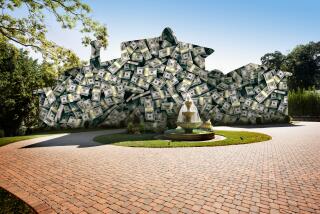Funds Invest on Westside
- Share via
As we all know, luxury prices abound on Los Angeles’ Westside.
Now we can add that prime office buildings there have become more costly than their counterparts in downtown Los Angeles.
While the recent center-stage purchases of downtown office towers have snared international headlines, and more than 70% of the those properties are now owned by foreign investors, the domestic buyers--principally pension funds--have moved rather quietly westward into what has become even higher-cost terrain.
An analysis of purchases made by domestic institutional buyers during the last two years shows that the cost of Class A buildings in the Westside averaged $302 per square foot, while prices downtown ranged from $208 to $335 per square foot, an average of $271.
Jack Rodman, managing partner of the Los Angeles office of Kenneth Leventhal & Co., the national CPA firm, found that the prices “reflect the play of market forces, with domestic and foreign investors competing head to head for the top properties.”
“Seen from the perspective we now have, Japanese investors have not overpaid,” he added. Rodman is the firm’s director of Pacific Rim activities.
The presence of the British and Dutch as major downtown property owners has been overshadowed by the recent Japanese buying binge and the resultant 25% ownership of Class A downtown structures they enjoy.
Rodman’s data indicates that the Japanese did not overpay for what they bought downtown. Many sources had thought they did, but Rodman shows that domestic investors are now paying higher prices for what they buy in the Westside, traditionally a secondary market to downtown. He describes the Japanese investment theory as obviously conservative--focusing on long-term ownership of quality projects in prime locations. Downtown office properties have suited their investment approach, and one major Japanese investor told him they have intentionally paid more for properties to meet acquisition objectives and to spark international recognition in the global business community.
“The average investor may question this inscrutable investment philosophy, but it has proven beneficial as these purchases have attracted widespread media attention. Japanese investors now have enhanced opportunities to see potential deals, thus giving them increased opportunities to bid for properties,” Rodman said.
“Nationally, U.S. real estate investment by the Japanese during the past four years has shown extraordinary gains in magnitude. The Japanese Data Base (compiled by his firm) revealed that Japanese investors poured $12.77 billion into U.S. real estate in 1987, up from $7.53 billion the year before.
“Investment in the first eight months of 1988 totaled $8.96 billion, more than all of 1985 and 1986 combined. The factors propelling this rise include the perceived security of U.S. real estate, growing familiarity with the market and the players, the appreciation of the yen, high real estate prices in Tokyo and an easing of investment restrictions abroad by the Japanese Ministry of Finance.”
While the accelerated purchases of American properties by the Japanese took place in 1986 and 1987, managers of American institutional funds--pension funds and insurance firms--had focused on the stock and bond markets, but in the wake of the October, 1987, stock market crash, domestic pension fund managers turned their attention to prime realty projects.
There will be much more of that to come, Rodman believes.
“Nationally, the largest 200 domestic pension funds increased their stake in real estate substantially between September, 1986 and September, 1987,” he said.
“Pension & Investment Age reported these funds invested $28 billion in real estate, a 7.1% jump. Managers of these funds report they plan to increase their investment in properties to approximately 10% of their portfolios by 1992.”
With the Japanese and other foreign players prominently in place downtown, the Leventhal survey shows that the domestic investors have zeroed in on Westside properties, buying eight prime properties there between 1986 and to date this year. The average cost per square foot was $302.
From 1986 to date, 10 office buildings purchased by the Japanese downtown showed an average cost per square foot of the aforementioned $271.
For Orange County, predictively, Rodman says, it’s just the beginning. Those bright, marble- and granite-clad buildings will become the next magnet for the foreign investors.
More to Read
Inside the business of entertainment
The Wide Shot brings you news, analysis and insights on everything from streaming wars to production — and what it all means for the future.
You may occasionally receive promotional content from the Los Angeles Times.










